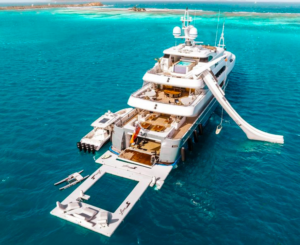
Starlink Maritime deployed on superyacht, fails mid-Atlantic

Starlink Maritime has been deployed on what it terms ‘the world’s most Instagrammed superyacht’, MY Loon, according to Teslarati.
“We have one superyacht, a $30 million, 180-foot superyacht. We upgraded to Starlink the day it became available for the maritime setup,” Paul Clarke told the Tesla, Elon Musk, SpaceX and Starlink focused website.
But, although the yacht service for at least six weeks before it crossed the Atlantic Ocean, things went awry at sea.
“With the boat crossing the Atlantic it was a good test to see if it was going to work and . . . it doesn’t. But I contacted Starlink support and they said that probably by November, they plan on turning it on in Q4,” Clarke says.
Previously Clarke says he was paying around $10,000 per month for speeds of around 40-80Mbs for his internet, now he’s paying around $5,000 and getting better speeds. Starlink Maritime comes with a $10,000 equipment fee.
Atlantic woes aside, Clarke says: “I think it’s great. Honestly, we are very happy with it in the early days and I think it’s a total game changer.” He cites streaming live games and Netflix on multiple platforms concurrently, including every television onboard, as a mark of success.
Loon has more than 62,000 followers on Instagram, where it posts about the yacht, crew, food onboard, and activities available during a charter. Clarke told Teslarati the yacht was worth $30 million. Loon can accommodate 12 guests and 14 crew and has an infinity pool, jacuzzi, and open-air bar.
According to Teslarati, Loon spent the summer in the Mediterranean and plans to spend the winter in the Caribbean. Clarke will test Starlink over the Atlantic when Loon goes back to the Mediterranean.
In July, SpaceX announced Starlink Maritime for boats. Initially it faced criticism for its high hardware costs – but some believe it could be transformative for cruise liners.
Satellites for at-sea internet connections can cost a cruise company an enormous amount of money, says space, ranging from hundreds of thousands to millions of dollars — maritime communications companies renting bandwidth can more or less charge what they want.
But with the one-off equipment purchase of $10,000 and a monthly charge of $5,000 for two Starlink terminals, cruise ships can slice their costs dramatically for potentially a much faster service. The website says the main downside is that the service currently only operates in the coastal seas of the USA (excluding Alaska), Europe (except the majority of Norway, Sweden and Finland), Australia, Brazil, Chile, the majority of southern Australia and New Zealand. SpaceX claims that it will progressively expand the service to new areas starting in the fourth quarter of 2022.
A representative for Inmarsat, the UK-based satcoms company, recently told space: “When you look at some of our competitors, particularly the ones you call new entrants (SpaceX and OneWeb), they simply aren’t well-positioned to meet the needs of the market — it’s very hard to provide that kind of coverage.
“The first-generation LEO constellation operators don’t have the wherewithal to deliver the security and resilience that customers need.”
Inmarsat recently announced that data usage on commercial maritime vessels has jumped more than threefold since 2019, according to new communications analysis. This underlines the shipping industry’s reliance on digital connectivity to enhance operating efficiency and safeguard crew welfare.
The study shows maritime demand has continued to rise as commercial shipping recovers following the peak of the pandemic – with data usage among Inmarsat maritime customers rising almost 70 per cent in the 12 months to mid-2022.
So far, SpaceX has launched more than 2,000 of its Starlink satellites into orbit and aims to have 12,000 in the sky by 2026. In 2020, rowers were caught off-guard by the sight of them streaming across the night skies.
All images courtesy of MY Loon via instagram.
